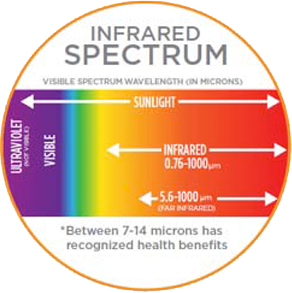What is Infrared?
Far infrared heat is a form of energy that directly heats objects. Human bodies naturally send and receive infrared waves, which are part of the Electromagnetic Spectrum—a range of all electromagnetic frequencies.
The Vital Zone
The range of far infrared waves generated by our bodies is 6 to 20 microns. Japanese medical researchers have found that the optimal micron output range is between 7 and 14 microns, often called the Vital Zone.

Far Infrared vs. Conventional Saunas
Today’s busy lifestyle can prevent us from actively sweating on a daily basis but a good infrared sauna will allow us to easily have that luxury. While bathing in a far infrared sauna, the body core temperature slowly rises and blood vessels dilate, increasing blood flow. As heat from the blood moves toward the skin’s surface, the body’s nervous system sends signals to the millions of sweat glands covering the body, stimulating perspiration. Far infrared rays penetrate 1.5” into the body inducing 2-3 times more perspiration than conventional saunas and easing muscle soreness while the surrounding air stays at a comfortable temperature [typically between 115 & 140 degrees F(46-60 degrees Celsius)]. The lower heat range is also safer for those concerned about cardiovascular risk factors that might be encountered in old-style hot-air saunas are usually between 175-195 degrees F(79-90 degrees Celsius).
A conventional sauna must rely only on indirect means of heat: convection (air currents) and conduction (direct contact of hot air with the skin) to produce its heating effects. In far infrared saunas, less than 20% of the infrared energy heats the air leaving over 80% available to be directly converted to heat within our bodies. This allows for a greater depth of heat penetration while the surrounding air remains at a relatively low temperature.


